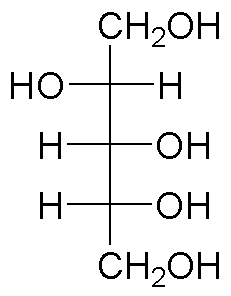D-Arabinitol is widely utilized in research focused on:
- Medical Diagnostics: Used as a biomarker for certain metabolic disorders, helping in the diagnosis of conditions like diabetes and kidney disease.
- Pharmaceutical Formulations: Acts as a sugar alcohol in drug formulations, providing a sweet taste without raising blood sugar levels, making it suitable for diabetic patients.
- Food Industry: Serves as a low-calorie sweetener and bulking agent in food products, appealing to health-conscious consumers.
- Biochemical Research: Employed in studies related to carbohydrate metabolism, aiding researchers in understanding metabolic pathways and enzyme functions.
- Cosmetic Applications: Incorporated in skincare products for its moisturizing properties, providing a gentle option for sensitive skin formulations.
General Information
Properties
Safety and Regulations
Applications
D-Arabinitol is widely utilized in research focused on:
- Medical Diagnostics: Used as a biomarker for certain metabolic disorders, helping in the diagnosis of conditions like diabetes and kidney disease.
- Pharmaceutical Formulations: Acts as a sugar alcohol in drug formulations, providing a sweet taste without raising blood sugar levels, making it suitable for diabetic patients.
- Food Industry: Serves as a low-calorie sweetener and bulking agent in food products, appealing to health-conscious consumers.
- Biochemical Research: Employed in studies related to carbohydrate metabolism, aiding researchers in understanding metabolic pathways and enzyme functions.
- Cosmetic Applications: Incorporated in skincare products for its moisturizing properties, providing a gentle option for sensitive skin formulations.
Documents
Safety Data Sheets (SDS)
The SDS provides comprehensive safety information on handling, storage, and disposal of the product.
Product Specification (PS)
The PS provides a comprehensive breakdown of the product’s properties, including chemical composition, physical state, purity, and storage requirements. It also details acceptable quality ranges and the product's intended applications.
Certificates of Analysis (COA)
Search for Certificates of Analysis (COA) by entering the products Lot Number. Lot and Batch Numbers can be found on a product’s label following the words ‘Lot’ or ‘Batch’.
Numéro de catalogue
Numéro de lot/série
Certificates Of Origin (COO)
This COO confirms the country where the product was manufactured, and also details the materials and components used in it and whether it is derived from natural, synthetic, or other specific sources. This certificate may be required for customs, trade, and regulatory compliance.
Numéro de catalogue
Numéro de lot/série
Safety Data Sheets (SDS)
The SDS provides comprehensive safety information on handling, storage, and disposal of the product.
DownloadProduct Specification (PS)
The PS provides a comprehensive breakdown of the product’s properties, including chemical composition, physical state, purity, and storage requirements. It also details acceptable quality ranges and the product's intended applications.
DownloadCertificates of Analysis (COA)
Search for Certificates of Analysis (COA) by entering the products Lot Number. Lot and Batch Numbers can be found on a product’s label following the words ‘Lot’ or ‘Batch’.
Numéro de catalogue
Numéro de lot/série
Certificates Of Origin (COO)
This COO confirms the country where the product was manufactured, and also details the materials and components used in it and whether it is derived from natural, synthetic, or other specific sources. This certificate may be required for customs, trade, and regulatory compliance.


